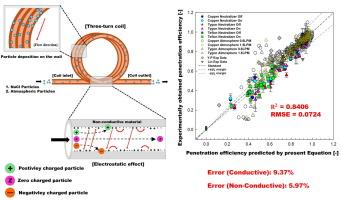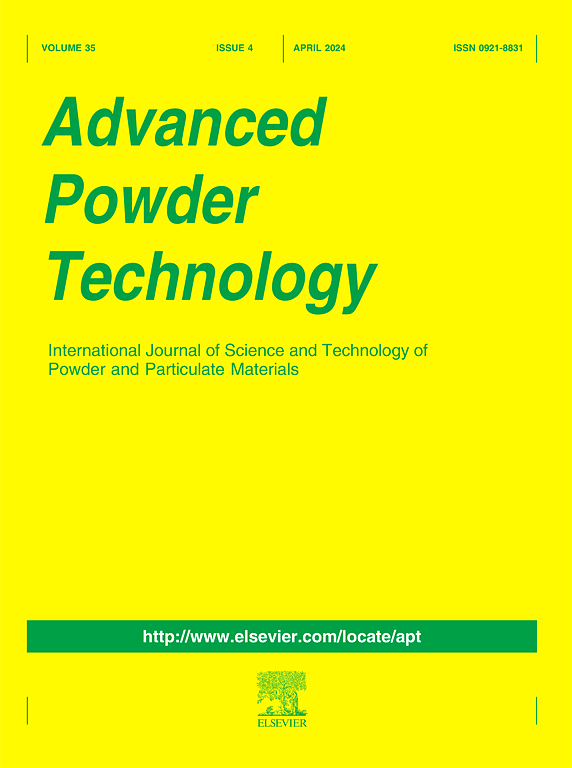气溶胶测量系统中导电和非导电线圈中纳米粒子渗透效率预测模型:实验研究与评述
IF 4.2
2区 工程技术
Q2 ENGINEERING, CHEMICAL
引用次数: 0
摘要
纳米粒子在药物输送、能量存储系统、半导体制造和环境研究等行业中发挥着重要作用。然而,纳米颗粒的利用往往是阻碍在转移过程中的颗粒损失。在本研究中,我们建立了气溶胶在导电(铜和泰贡)和非导电(特氟龙)材料的三匝线圈中穿透效率的预测模型。我们对受控条件下的NaCl颗粒和直接来自周围环境的大气气溶胶颗粒进行了采样。结果表明,渗透效率很大程度上取决于线圈材料,不导电的聚四氟乙烯由于静电效应而表现出明显的颗粒损失。与现有模型的对比分析揭示了它们在捕捉多匝线圈结构中扩散、二次流和静电效应耦合影响方面的局限性。为了克服这一限制,我们开发了一种新的预测模型,其中包含一个新参数(Γ),可以在最广泛的工作条件下准确估计纳米颗粒在多匝线圈中的渗透效率。考虑到静电力因素,我们的模型适用于导电和非导电线圈类型,具有最高的精度,导电线圈的平均误差为9.37%,非导电线圈的平均误差为5.97%。这项研究也为改进气溶胶系统提供了实用的设计指南和在线工具。本文章由计算机程序翻译,如有差异,请以英文原文为准。

Nanoparticle penetration efficiency prediction model in conductive and non-conductive coils for aerosol measurement system: Experimental research and critical review
Nanoparticles play an important role across industries such as drug delivery, energy storage systems, semiconductor manufacturing, and environmental research. However, the utilization of nanoparticles is often hindered by particle loss during transfer. In this study, we developed a predictive model for the penetration efficiency of aerosol in the three-turn coil with conductive (Copper and Tygon) and non-conductive (Teflon) materials. We conducted samplings for NaCl particles under controlled conditions and atmospheric aerosol particles directly from the ambient environment. The results demonstrated that penetration efficiency strongly depends on coil material, with non-conductive Teflon exhibiting significant particle losses due to electrostatic effects. Comparative analysis with existing models revealed their limitations in capturing the coupled influence of diffusion, secondary flow, and electrostatic effects in multi-turn coil configurations. To overcome this limitation, we developed a novel predictive model incorporating a new parameter (Γ), which enables accurate estimation of nanoparticle penetration efficiency in multi-turn coils under the broadest operating conditions. By accounting for electrostatic forces, our model is applicable to both conductive and non-conductive coil types, achieving the highest accuracy, with average errors of 9.37% for conductive and 5.97% for non-conductive coils. This study also provides practical design guidelines and online tool for improving aerosol-based systems.
求助全文
通过发布文献求助,成功后即可免费获取论文全文。
去求助
来源期刊

Advanced Powder Technology
工程技术-工程:化工
CiteScore
9.50
自引率
7.70%
发文量
424
审稿时长
55 days
期刊介绍:
The aim of Advanced Powder Technology is to meet the demand for an international journal that integrates all aspects of science and technology research on powder and particulate materials. The journal fulfills this purpose by publishing original research papers, rapid communications, reviews, and translated articles by prominent researchers worldwide.
The editorial work of Advanced Powder Technology, which was founded as the International Journal of the Society of Powder Technology, Japan, is now shared by distinguished board members, who operate in a unique framework designed to respond to the increasing global demand for articles on not only powder and particles, but also on various materials produced from them.
Advanced Powder Technology covers various areas, but a discussion of powder and particles is required in articles. Topics include: Production of powder and particulate materials in gases and liquids(nanoparticles, fine ceramics, pharmaceuticals, novel functional materials, etc.); Aerosol and colloidal processing; Powder and particle characterization; Dynamics and phenomena; Calculation and simulation (CFD, DEM, Monte Carlo method, population balance, etc.); Measurement and control of powder processes; Particle modification; Comminution; Powder handling and operations (storage, transport, granulation, separation, fluidization, etc.)
 求助内容:
求助内容: 应助结果提醒方式:
应助结果提醒方式:


